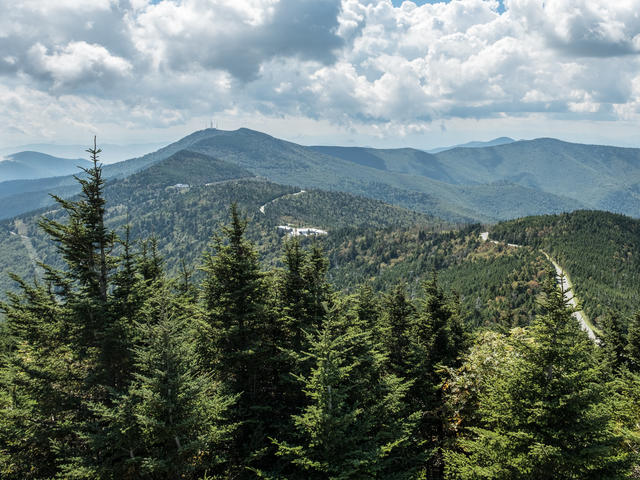Home » Regions » North America » Eastern Temperate Forests » Ozark, Oauchita-Appalachian Forests » Blue Ridge » High Mountains
High Mountains
Last updated: September 2nd, 2020
Page contents
↑About the High Mountains
The High Mountains is a region of the Blue Ridge, encompassing several disjoint high-elevation regions, generally over 4,500 feet.This region has a colder climate than its surroundings, reaching winter lows more characteristic of regions much farther north, and also averaging particularly cool summers. Precipitation is also particularly high year-round, and wind speeds can be high. The cool temperature change the soil composition by slowing decomposition of organic matter; soils tend to be thinner and more acidic than at lower elevations. Wind and ice limit vegetation.
Originally, this region represented the southernmost limit of spruce-fir forests, which covered most of the higher elevations in this region, with red spruce (Picea rubens) and fraser fir (Abies fraseri) dominant. At slightly lower elevations, the forests included northern red oak (Quercus rubra), northern red oak (Quercus rubra), yellow birch (Betula alleghaniensis), yellow buckeye (Aesculus flava), and sugar maple (Acer saccharum) were dominant trees. Some summits, slopes, and ridgetops support heath balds, with catawba rosebay (Rhododendron catawbiense), carolina azalea (Rhododendron carolinianum), great laurel (Rhododendron maximum), mountain laurel (Kalmia latifolia), or grassy balds or alpine meadows, with flattened oatgrass (Danthonia compressa) and a variety of other herbaceous vegetation.
Spruce-fir forests in this region are threatened by multiple factors, including global warming pushing them to progressively higher elevations, where there is less space available, the introduction of the balsam wooly adelgid, and air pollution. Alpine meadows are also particularly threatened by global warming. In addition to plants, these high-elevation communities also support locally-endangered animals at the southern limits of their ranges. The lower-elevation forests in this region have largely retained their original composition.
At lower elevations, this region is surrounded variously by the Southern Crystalline Ridges and Mountains and the Southern Metasedimentary Mountains.
 This view, taken from atop Mount Mitchell, shows the High Mountains region of the Blue Ridge, where the landscape is dominated by conifers, and open at the highest elevations. This is a crop of a photo © Kolin Toney, CC BY-SA 2.0, Source.
This view, taken from atop Mount Mitchell, shows the High Mountains region of the Blue Ridge, where the landscape is dominated by conifers, and open at the highest elevations. This is a crop of a photo © Kolin Toney, CC BY-SA 2.0, Source.Plant Lists & In-Region Search
We do not yet have data to generate plant lists for a region as fine-tuned as this one. However you can move up to the broader Blue Ridge and generate lists for that region: native plants or all plants. Or search that region's plants here:
↑References
1. Comstock, J.A.; Griffith, G.E.; Omernik, J.M. "Ecoregions of North Carolina: Regional Descriptions", (2002) Web.
2. Griffith, G.E.; Omernik, J.M.; and Azevedo, S.H. "Ecoregions of Tennessee (Poster)", U.S. Geological Survey, Reston, VA (1998) Web.


